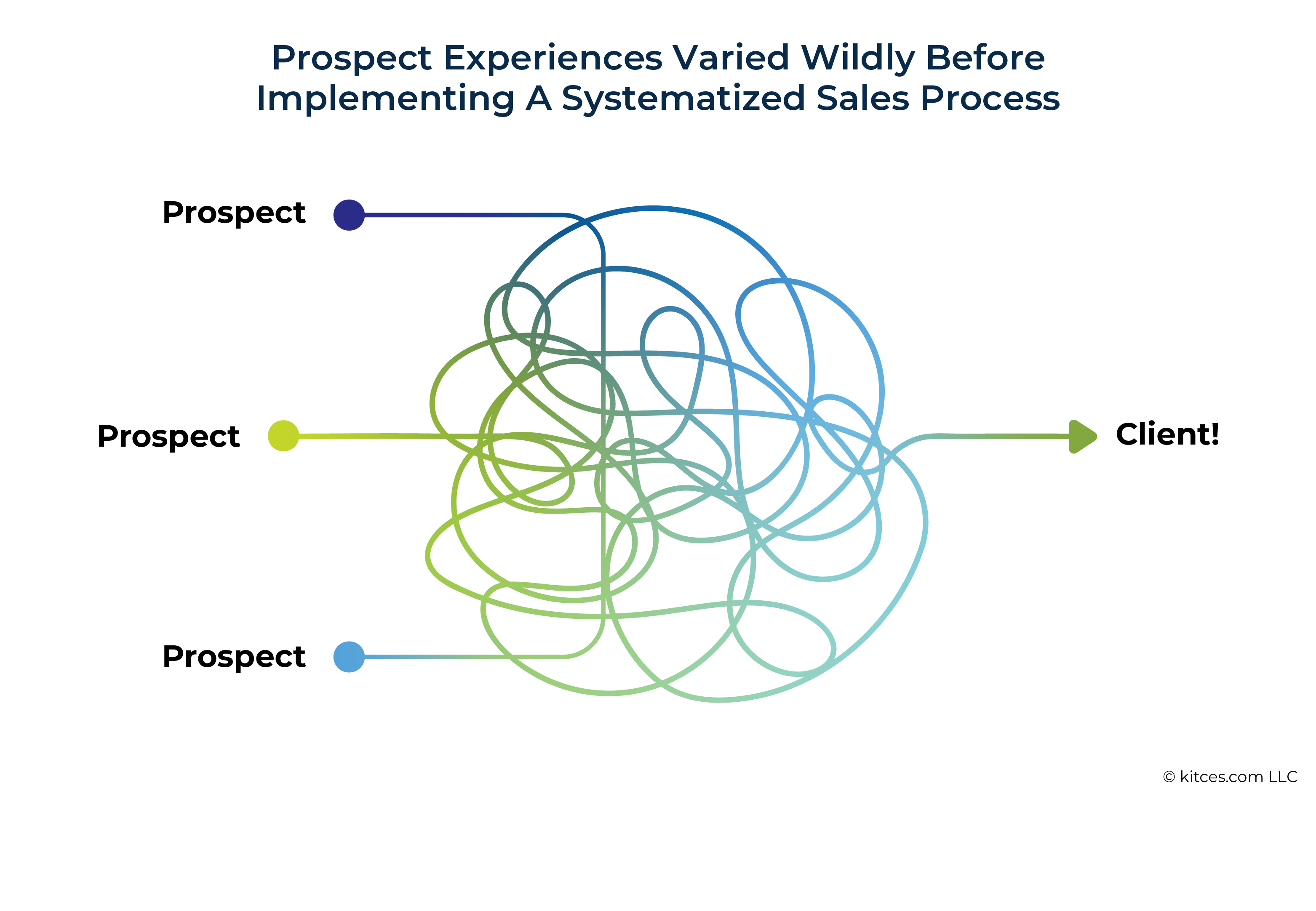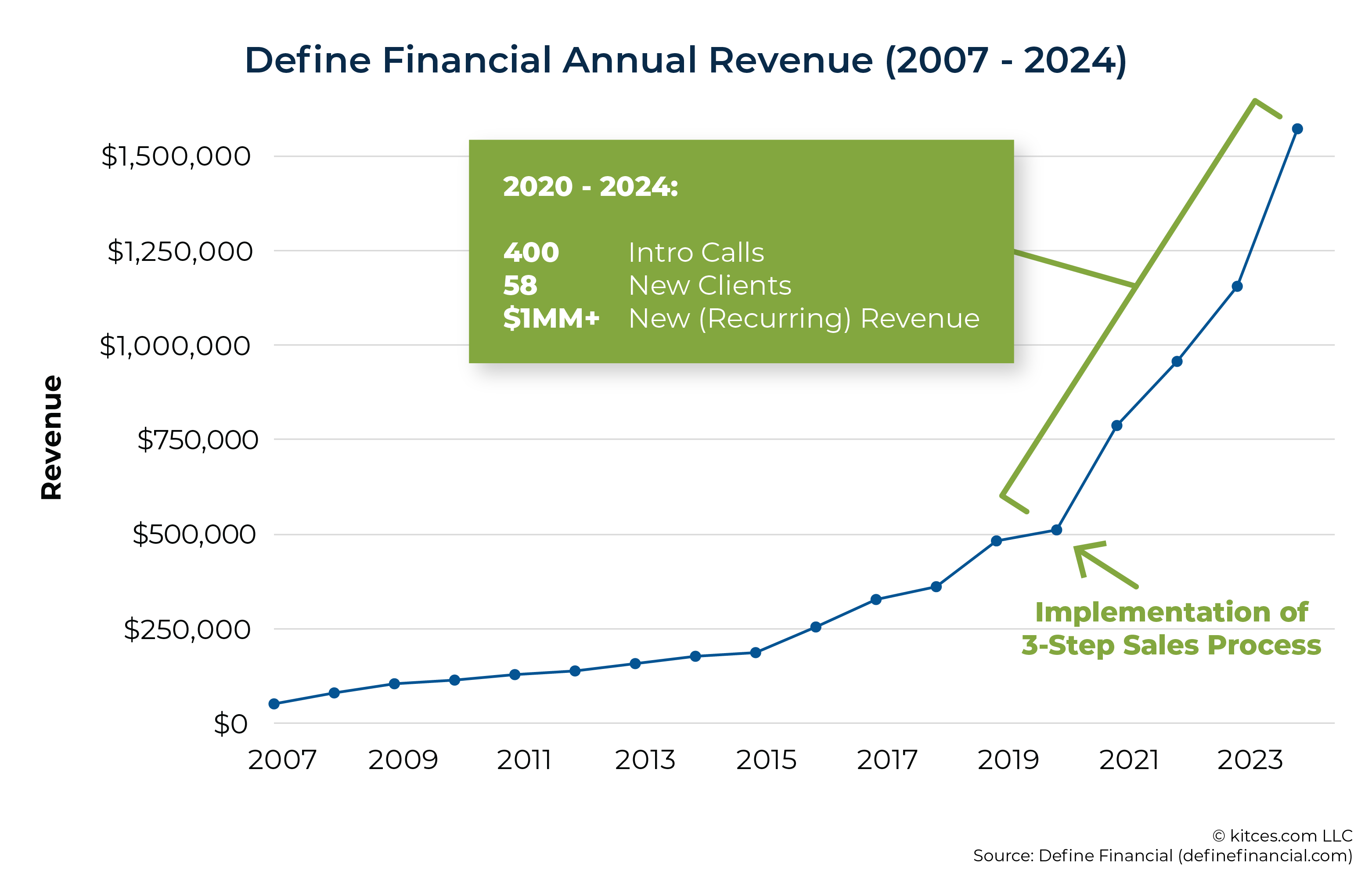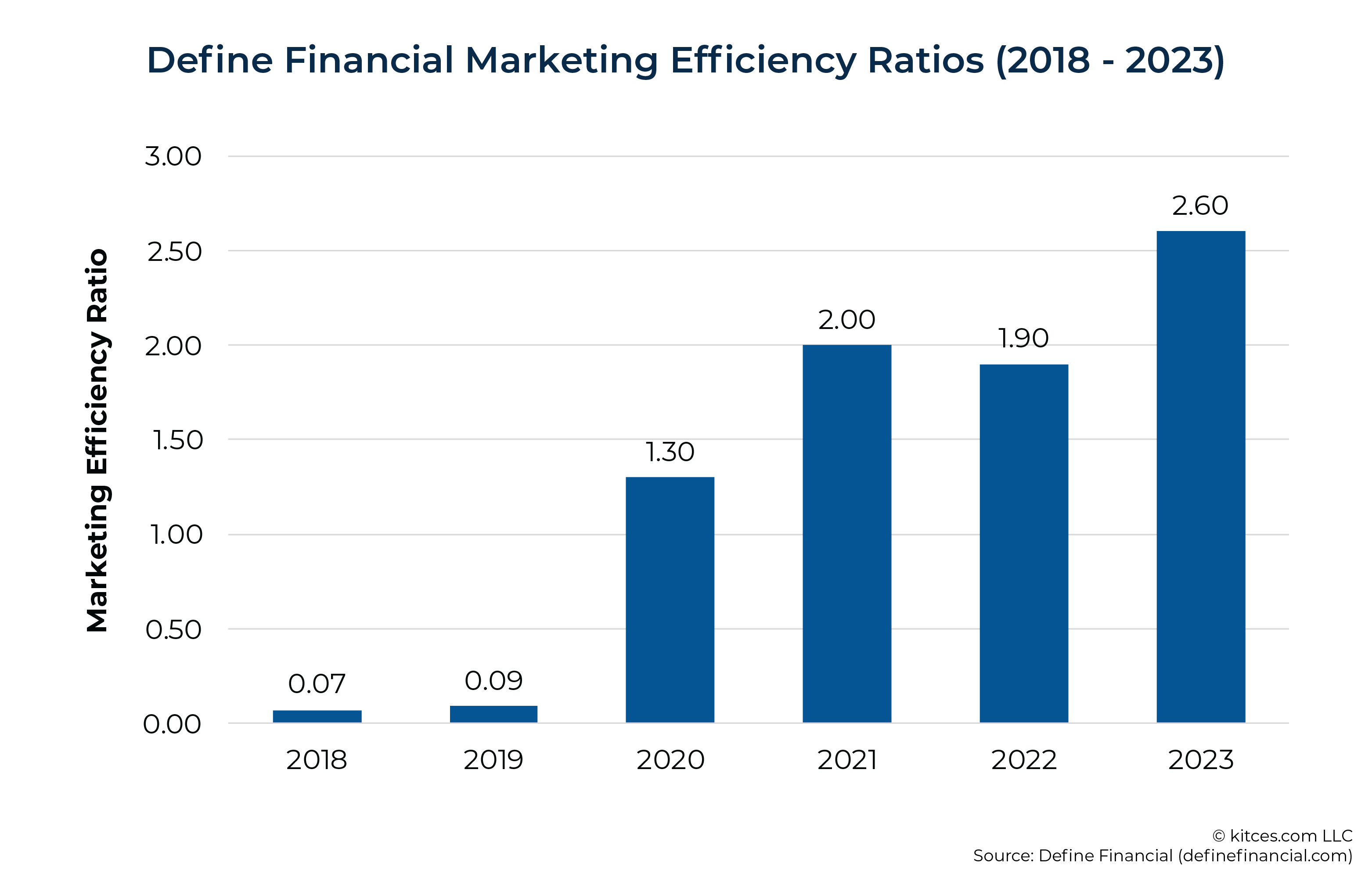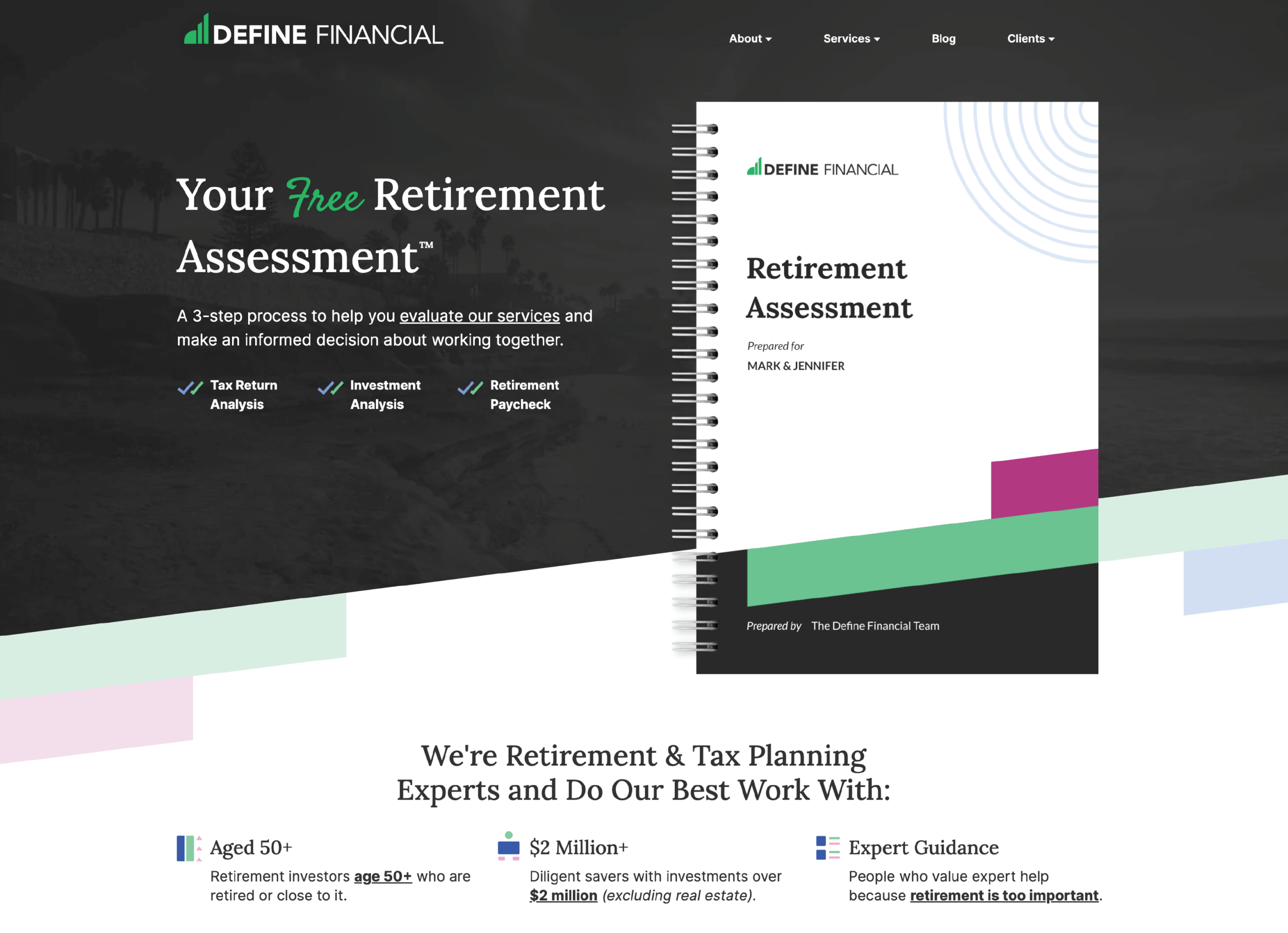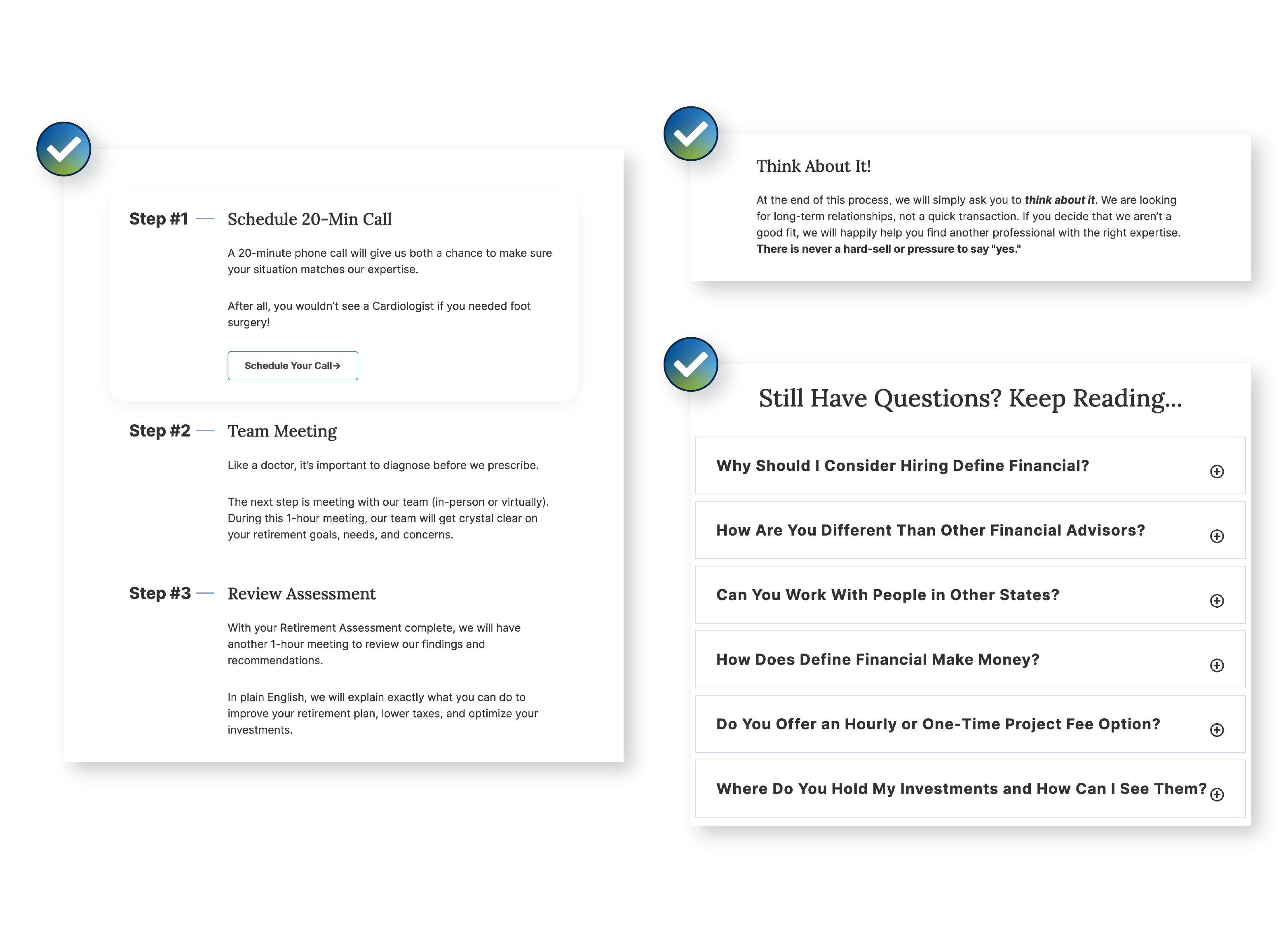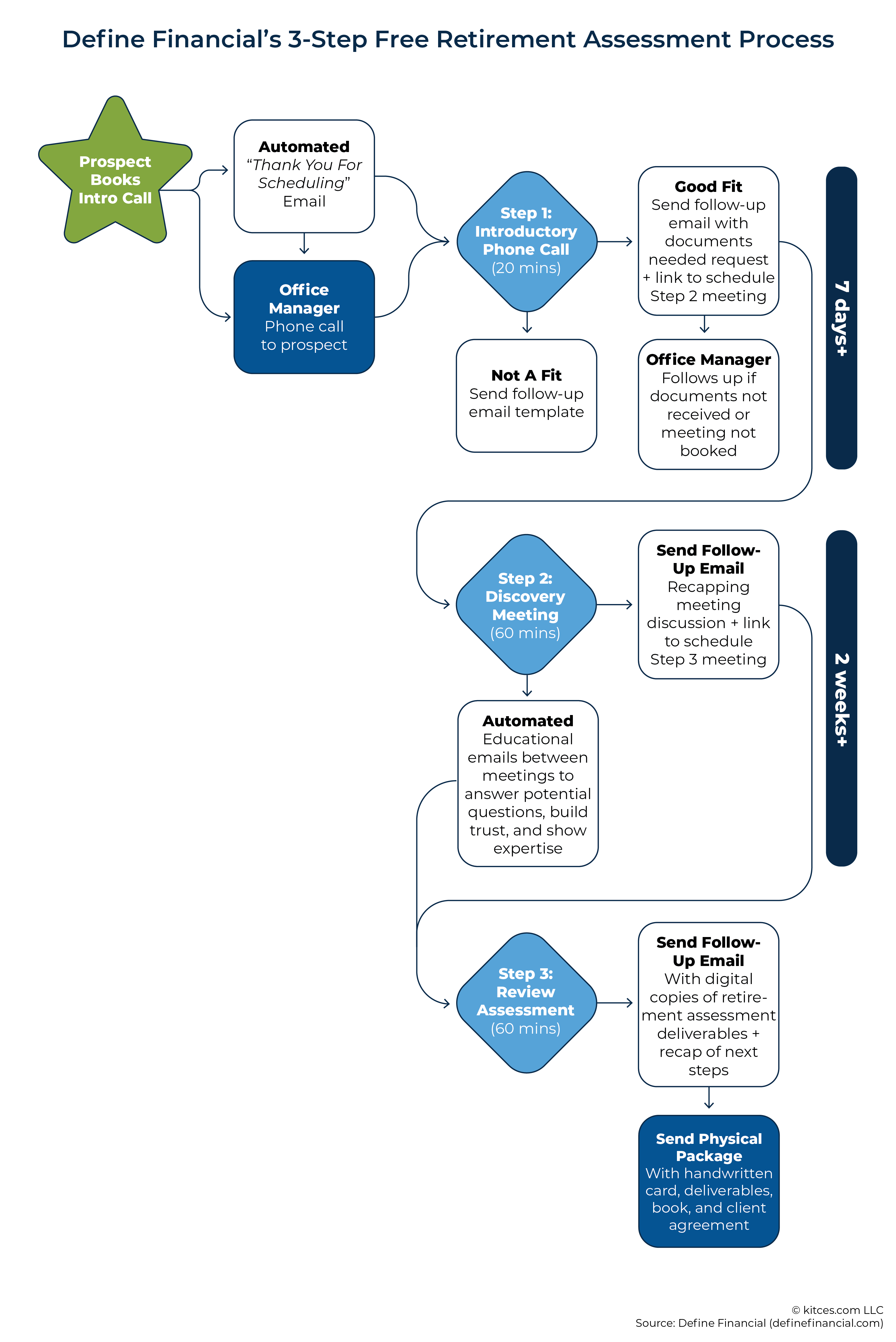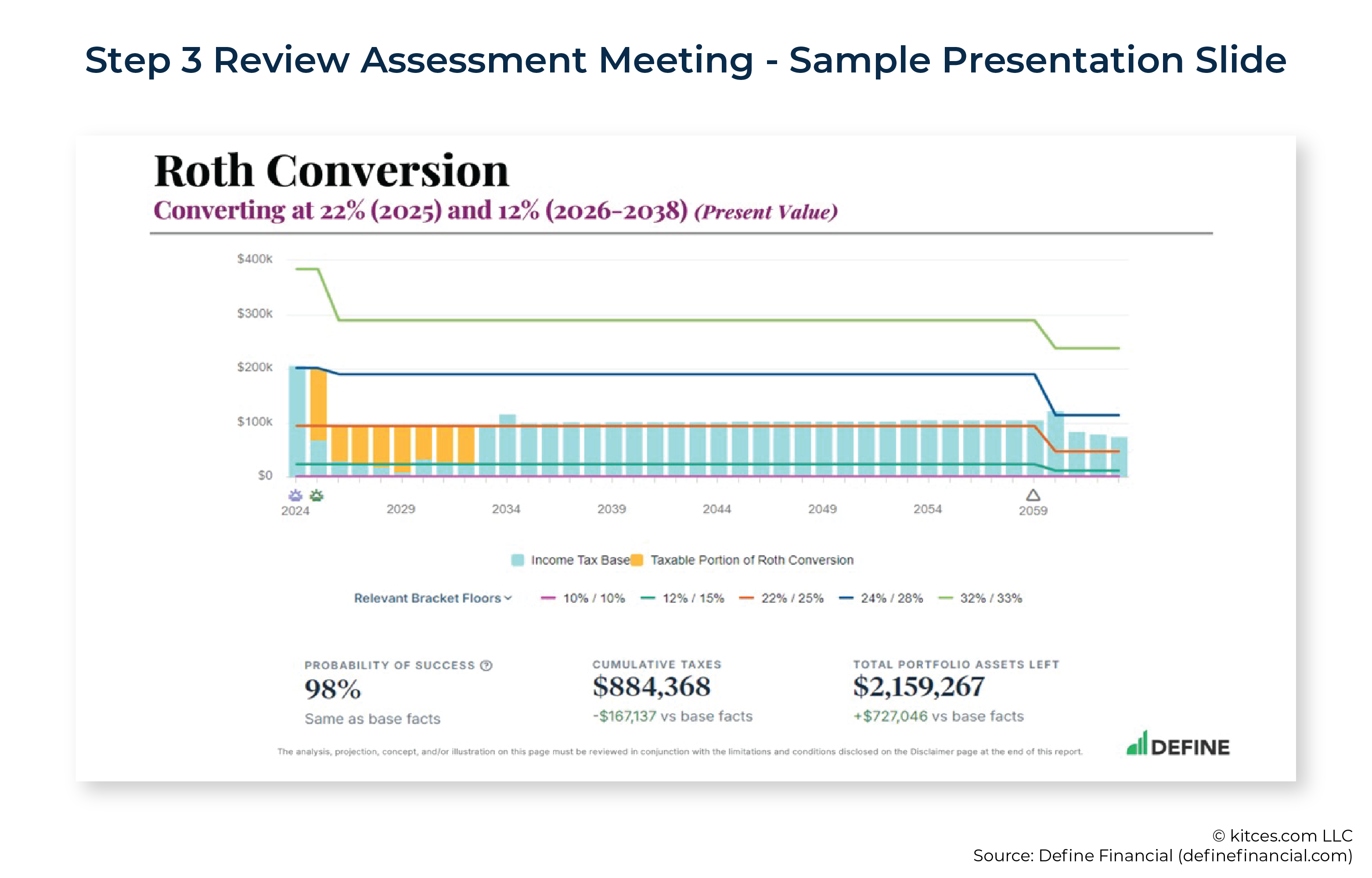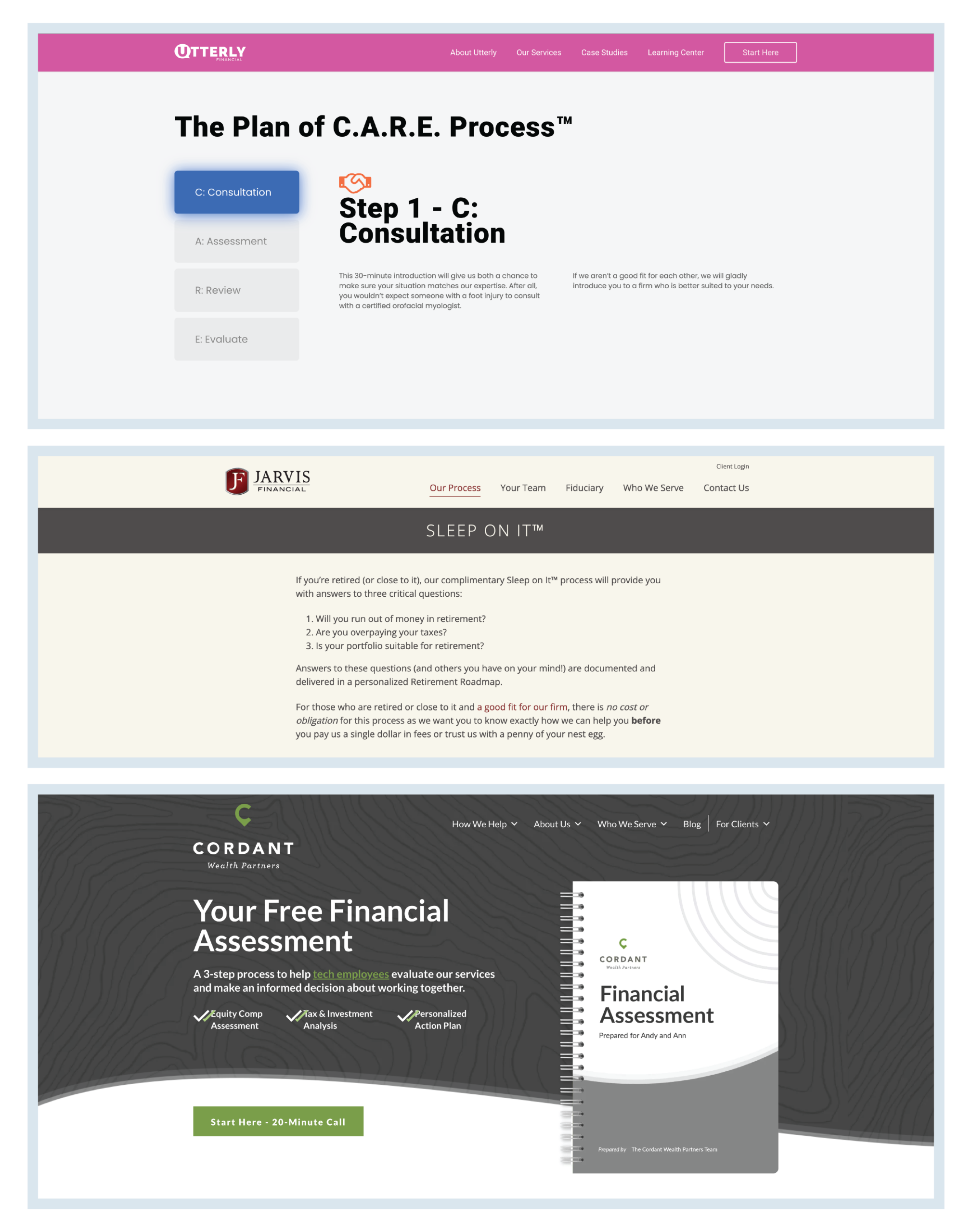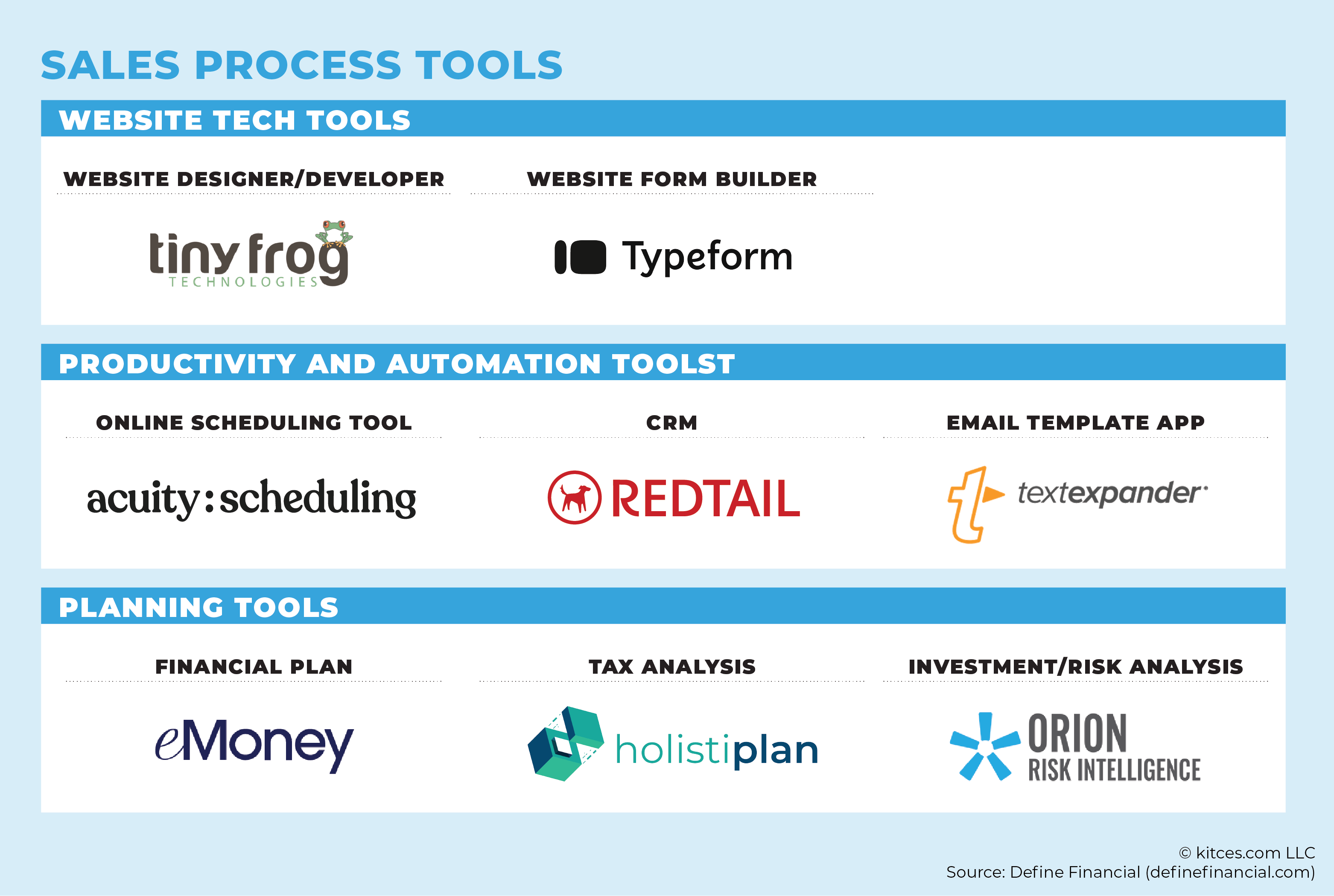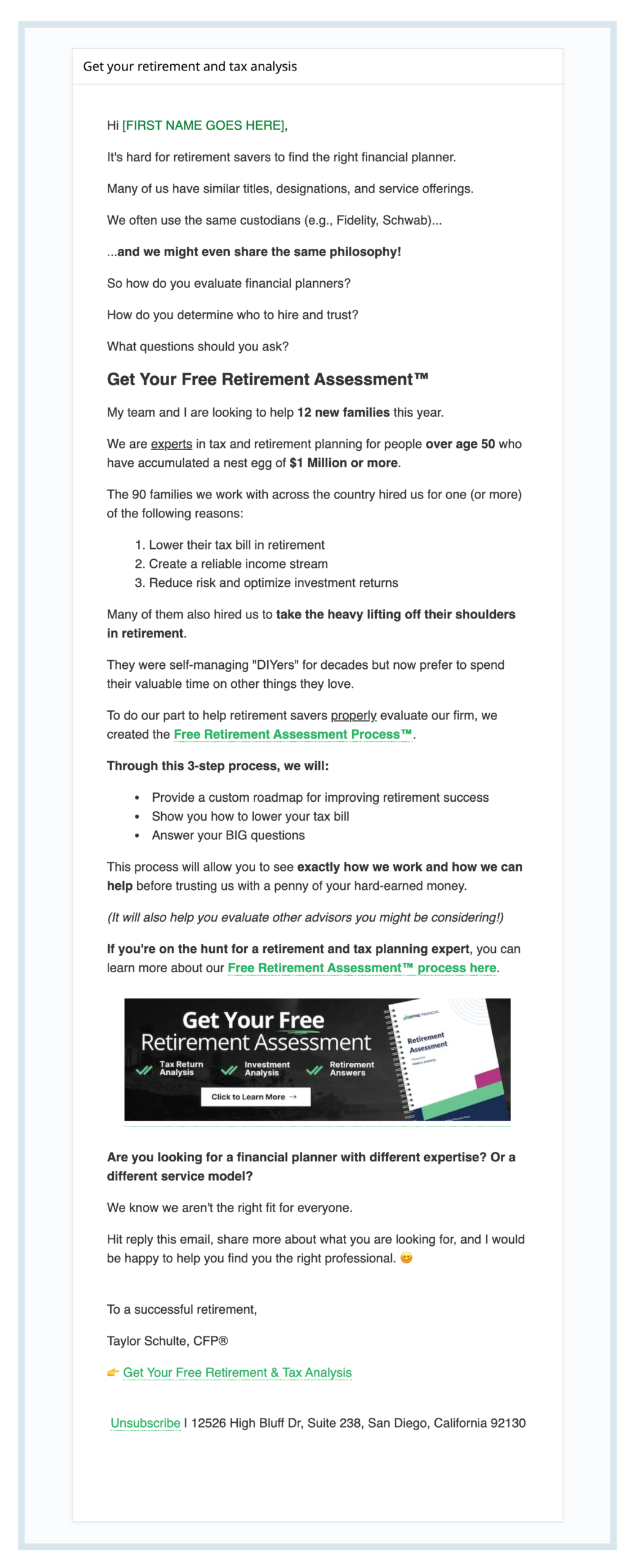Executive Summary
Over the past decade, a growing number of advisors have expanded into offering comprehensive financial planning services, reflecting a shift that not only helps them stand out from (increasingly commoditized) portfolio management offerings but also supports clients' broader financial goals. However, comprehensive planning is an intangible service, which can make it challenging for advisors to convey its value – especially when meeting with prospective clients who may be unfamiliar with what 'financial planning' entails. This can be particularly challenging when advisors work with clients who have diverse planning needs.
In this guest post, Taylor Schulte, founder of Define Financial, an independent RIA based in San Diego, CA, shares his approach to overcoming these challenges by selecting a client niche and implementing a 3-step sales process. Together, these strategies have enabled him to clearly demonstrate his value to prospective clients contributing to a remarkable $1 million increase in recurring revenue over just 4 years.
To start, Taylor refined his ideal client profile to focus on those he could best serve: diligent savers over age 50 with a retirement nest egg between $2M and $10M. These clients, typically in or near retirement, face key challenges like reducing taxes, managing investment risk, and maximizing income. With a clear niche, Taylor developed a client-centered sales process focused on value, not on pressure to become a client.
Taylor's process starts even before the first meeting, introducing prospects to the firm and its "Free Retirement Assessment Process". Those interested can then schedule a 20-minute introductory phone call, where Taylor uses a script to determine a potential fit to work together. If both parties agree, they proceed to a 60-minute discovery meeting to explore the prospect's goals and reasons for seeking advice.
After this meeting, Taylor waits 2 weeks before the final review assessment meeting. This timeline not only allows for the prospect to provide their information and Taylor's team to complete the analysis, but also gauges the prospect's commitment to a long-term relationship. In the final 60-minute review, Taylor presents the Retirement Assessment, covering 3 key questions: how to maximize income, lower taxes, and optimize investments in retirement. He also discusses fees and the onboarding process but encourages prospects to "think about it" before deciding – focusing on long-term value over a quick close.
Ultimately, the key point is that developing a structured sales process tailored to the specific needs of a well-defined client niche not only enhances operational efficiency but also builds trust and rapport with prospects. This approach can lead to higher conversion rates while driving substantial revenue growth and profitability. And by aligning services with the priorities of a targeted clientele, advisors can create lasting relationships and build a thriving, sustainable business!
Over the last 10 years, investment management has become increasingly commoditized, influencing me (and many other advicers!) to expand my financial planning services and commit to a "comprehensive wealth management" model. When investors can get portfolio management services from a discount broker or robo-advisor for 25 basis points, I need to demonstrate more value to command a premium price.
While comprehensive financial planning is arguably the "anti-commoditizer", it's not enough to simply tell prospective clients that I offer this valuable service and expect them to understand why it warrants a higher fee. Financial planning is an intangible service, which makes it difficult for prospective clients to easily assess its quality and value. Additionally, there isn't a clear and consistent definition of what financial planning actually is. As a result, it can be challenging to clearly demonstrate and 'sell' the value of planning services, and prospective clients may struggle to determine whether the benefits outweigh the cost.
To address this challenge, I adopted a clearly defined niche and then implemented a 3-step sales process to more effectively and efficiently demonstrate my value to my ideal clients. This niche-focused process has had a conversion rate of 60%+ and is directly responsible for more than $1 million in new, recurring revenue in the last 4 years.
By effectively showing my value, I've helped prospective clients improve their ability to evaluate the intangible services included in my comprehensive wealth management model. I've also ensured that clients hire me for the right reason: because they know I have the expertise to solve their specific problems, not because of a good sales pitch.
Before: Unpredictable Growth Resulting From An Unsystematized Sales Process
Before I implemented a systematized sales process, I didn't have a process at all. I was fixated more on talking to as many prospective clients as possible than on creating a system for demonstrating my value to the people I have the expertise to help.
Every prospective client had a different experience when they inquired about my services and evaluated my firm. The number and length of meetings and phone calls, as well as the deliverables and proposals I provided, varied wildly by prospect.
The outcome of my inefficiencies was predictable: a chaotic practice with slow, unpredictable growth. I was eventually managing $73 million for 57 families and generating $450,000 in recurring annual revenue, but it took me 12 frustrating years to get there. In addition, focusing on the quantity of prospects instead of the quality (or fit) resulted in me struggling to efficiently serve a wide variety of clients in different age groups and with different needs, goals, and pain points.
Ultimately, I recognized that the path I was on was not sustainable – it was hindering my ability to leverage my time, delegate tasks, and achieve my growth goals without sacrificing the value existing clients deserved (and expected!).
After: $1 Million Revenue Growth With A Single Niche
Before I could begin creating and implementing an efficient sales process, I needed to clarify who I did my best work for and the pain points I had the expertise to solve. In other words, I needed to adopt a clearly defined niche to better communicate and demonstrate my value proposition to prospective clients.
As many advisors can likely relate, this was easier said than done. I was terrified to commit to a niche, afraid that alienating most of the population would lead to missed opportunities and more significant growth challenges.
However, I trusted my peers, mentors, and research, and went through the challenging process of narrowing down who my ideal client was:
- Diligent savers over age 50 with a nest egg between $2MM and $10MM who are retired or close to it.
- Primary pain points: reducing taxes in retirement, managing investment risk, and safely (and tax-efficiently) creating a retirement paycheck.
My fear of committing to a niche, while understandable and relatable, couldn't have proved to be more unfounded. Once I made the change, it was easier to design and implement an efficient sales process that has led to better-fit clients and higher growth rates than I could have imagined.
Specifically, since adopting a niche and implementing my 3-step sales process in 2020, I've added more than $1 million in new, recurring annual revenue – more than double the amount added in the first 12 years of my career!
With a systematized sales process built for my niche, I've also been able to leverage my time better and, in turn, significantly improve our marketing efficiency ratio, measured by the cost (in time and dollars) of getting a new client, divided by the revenue generated by the new client.
This isn't just my unique experience, either; the latest Kitces Research on Advisor Marketing suggests that niche firms have higher marketing efficiency scores, greater satisfaction with the 'fit' of prospects, and higher average client growth rates (58%) than non-niche firms (26%).
A Successful Sales Process Leads With Value (Not Pressure)
Advisors who cringe at the idea of 'persuading' or 'selling' are not alone. When I started my career in 2007, I was shipped off to sales training to learn scripts and tactics for successfully getting prospects to "say 'yes'". Those tactics never felt comfortable or authentic to me, and my lack of knowledge of an alternative approach is one major reason why it took me 12 years to reach $400,000 in annual revenue.
Eventually, my struggling, unpredictable growth led me to invest in myself and learn from successful marketers and business coaches. One of the coaches was Matthew Jarvis, President of Jarvis Financial and Co-Founder of The Perfect RIA. Matthew helped me understand that a successful (and sustainable!) sales process that converts 'perfect fit' prospects into lifetime clients shouldn't contain any arm-twisting tactics; it should show prospective clients exactly how I will solve their biggest challenges. He also taught me exactly how he implemented this approach in his practice through the Sleep on It™ process, which gave me a proven framework for taking action.
Initially, I was skeptical about showing prospective clients how I'd address their problems. I thought, "If I show them the solution, why would they hire me if they understood how they could do it themselves?" Like committing to a niche, I found the opposite of my concerns to be true. I found that showing prospective clients my detailed solution allowed them to properly assess the quality of my advice and the value of my services. It also resulted in clients hiring me because, by explaining the solution, they were able to understand the complexity of implementing my advice and determined they didn't want to spend their valuable time doing the heavy lifting. In other words, with this approach, clients are able to make a fully informed decision when "saying 'yes'", mitigating future surprises and supporting healthy, long-term relationships.
My 3-Step Sales Process (A.K.A. The Free Retirement Assessment Process)
Dan Sullivan, co-founder of Strategic Coach, teaches a concept called "packaging":
Packaging is the means by which you differentiate yourself from all competition and stereotyping in a positive, appealing, and permanent manner. It is simply a way of taking the value that is already being created and communicating it in a more appealing and engaging way.
~Dan Sullivan
Packaging starts by clearly defining the advisor's value proposition and documenting a step-by-step process for presenting it.
My value proposition:
We help high-net-worth retirement savers over age 50 who are retired or close to it lower taxes, invest smarter, and maximize income.
My 3-step process for presenting the value proposition (i.e., my sales process):
- Step #1 – Introductory Phone Call (20 minutes)
- Step #2 – Discovery Meeting (60 minutes)
- Step #3 - Proposal Meeting (60 minutes)
With this information documented, the next suggested step was to name my process so I could clearly and concisely articulate its value.
While "Taylor's 3-Step Sales Process" has a nice ring to it, I decided to follow the advice of people smarter than me and settled on the Free Retirement Assessment Process. The name follows the basic tenets of being positive, appealing, and descriptive. It has proven to contribute to more consistent internal communication and to help distinguish our advertised service and client experience from other offerings.
On my firm's retirement assessment landing page, we clearly state the purpose of the process and who it is designed for (i.e., our ideal client).
We also share the details of each step, what to expect at the conclusion of the process, and answers to frequently asked questions.
By providing this information upfront, we set proper expectations, mitigate surprises, and ensure that the right people are inquiring about our process: High-net-worth retirement savers over age 50 who are seeking professional help with retirement and tax planning.
On the surface, my basic 3-step process doesn't look very unique—in fact, it might look similar to yours! What differentiates the process and supports its success is how we thoughtfully implement each step and deliver an unforgettable experience that feels very different from other firms that a prospective client may be evaluating.
How My 3-Step Sales Process Works
The Free Retirement Assessment Process is designed to help prospective clients evaluate our firm by showing them how we can solve their biggest pain points. And since I committed to a clear niche and uncovered the exact challenges my firm has the expertise to solve, I was able to design our process and deliverables to answer the same 3 questions for everyone:
- How can you maximize income in retirement?
- How can you lower your tax bill?
- How can your investments be optimized?
Addressing the same questions and pain points for every prospective client dramatically improves the process's efficiency without sacrificing effectiveness.
Step #1: Introductory Phone Call (20 Minutes)
Purpose: The primary purpose of the introductory phone call is to learn more about the prospective client's needs, goals, and challenges and ensure we have the right expertise to help. We also use this step to answer general questions and share more about the Free Retirement Assessment Process.
Process: We use a templated script to guide our introductory call, allowing us to deliver a repeatable experience and make the best use of the allotted time. Instead of handwriting notes, we type what we gather during the call directly into our "Client Data Summary" spreadsheet template. This spreadsheet is maintained and updated throughout the entire sales process as we collect more information. Maintaining this spreadsheet prevents my team from having to search through CRM notes to locate the exact data points needed to successfully complete each step of the sales process.
Outcome: At the end of the call, we collaboratively determine whether there is a potential fit to work together and if we should proceed to the next step in the Free Retirement Assessment Process.
If both parties agree to proceed, we send a templated follow-up email immediately after the call containing a recap of the discussion and a link to our online calendar so they can schedule their Discovery Meeting (Step 2). In that follow-up email, we also provide a list of required documents (e.g., most recent tax return and investment account statements) for them to send to us at least 3 days before their next meeting.
If we and/or the prospective client determine that we are not the right fit, we will offer to introduce them to a more fitting advisor and send them a templated follow-up email with helpful resources.
How We Make The Process Even Better:
Ensuring Selectivity. We intentionally designed the scheduling process to be selective, ensuring that only the right people actually schedule introductory phone calls with us. For example, our introductory call scheduling link cannot be found anywhere on our homepage or other sub-pages in the navigation menu. Instead, throughout our website and in content marketing channels, prospective clients are invited to visit the Free Retirement Assessment landing page and learn more about our process for evaluating our firm.
If page visitors determine that we potentially have the right expertise to help and want to schedule an Introductory Phone Call (Step 1), a Call To Action (CTA) link on the assessment landing page leads them to a form to complete. The form contains conditional logic and only presents our online calendar if their answers align with the type of clients we work best with. Year-to-date, over 400 people have completed the form, but only 70 have successfully scheduled introductory phone calls.
Making It Personal. When a prospective client schedules a phone call, we want the experience to immediately feel different from any other firm they might be considering. To achieve that, we leverage a blend of technology and human touch.
For example, we replace the typical (and boring) online calendar confirmation email summarizing the date, time, and location of the call with a thoughtful welcome email. This welcome email template is automatically sent from our online calendar system immediately after they schedule their call. It addresses the prospective client(s) by their first name(s), thanks them for considering our firm, and summarizes exactly what they can expect during their upcoming call.
In addition, during normal business hours, our Client Service Manager is prompted by our workflow to call the prospective client as quickly as possible when their Introductory Phone Call confirmation hits her inbox. The purpose of this call is to immediately build rapport and humanize the engagement – an engagement that has been driven by technology up to this point. She uses a written script to introduce herself, confirm the appointment details, and ask if they have any additional information to share that may be helpful to know in advance of the call.
Step #2: Discovery Meeting (60 Minutes)
Purpose: In addition to letting us put faces to names and get to know each other, the discovery meeting helps us dive deeper into the prospective client's needs, goals, and primary reasons for seeking professional help. Learning more about them and gathering additional information is critical to ensuring we produce and present an impactful Retirement Assessment deliverable that shows them how we can help in the final step.
Process: At least 3 days before this meeting, the prospective client securely uploads complete copies of their most recent tax return and investment account statements. Once received, we review and analyze these documents and summarize our findings in an internal-only "Step 2 Meeting Packet". The meeting packet also includes a list of 10–15 questions we need (or want) to ask during the meeting to ensure we have an accurate understanding of the prospect's current situation, goals, and pain points.
We begin the meeting by recapping our 3-step process, explaining the purpose of the current meeting, and describing the next steps after the meeting concludes. In other words, we continue to set proper expectations to create a positive experience and avoid surprises. After asking if they have any questions, we begin asking our questions and taking notes. The prospective client does 95% of the talking during this meeting.
Here are some of the questions we might ask a prospective client during the meeting:
- What are your plans for filing for Social Security benefits?
- Tell us more about $X charitable contribution you made last year.
- When was the last time you updated your estate documents?
- Is leaving money to your heirs at the end of life important to you? If so, tell us more about this goal.
- How have you structured your retirement account beneficiaries?
- Tell us more about how you arrived at your current asset allocation.
- You have a large, concentrated position in XYZ stock – what are your future plans for this security, managing the risk, and navigating the taxes?
- What tax planning opportunities have you taken advantage of?
- What solutions are you considering for healthcare coverage before you're eligible for Medicare?
- Do you have long-term care insurance? If so, tell us more about your policy. If not, how did you arrive at that decision?
Outcome: At the conclusion of the meeting, we remind the prospective client that we will need at least 2 weeks to complete our analysis and build their Retirement Assessment. We immediately follow up with a templated email that contains a brief recap of our discussion and a unique link to our online calendar to schedule their Step 3 meeting. (The unique online calendar link included in this email template has availability 'rules' preventing them from scheduling their next meeting within the next 2 weeks.)
How We Make The Process Even Better:
Confirming The Right Fit. While it doesn't always take us 2 weeks to complete our analysis and build their Retirement Assessment, intentionally spacing out meetings with prospective clients ensures that existing clients remain our top priority. It also ensures that the people evaluating our firm are truly committed to hiring the right professional. We are interested in long-term client relationships, not quick transactions. If someone doesn't want to invest 4–6 weeks of their time in making one of the most important decisions of their life, we aren't going to be a good fit for them, and the length of the process filters them out.
Managing Client Questions. It's common for people to ask us for our thoughts, opinions, and/or recommendations throughout this meeting. For example, "Do you think I should keep this annuity?" or "Am I on track for retirement?" and even "What is your investment philosophy?" While it's tempting, answering these questions has proven to derail us from gathering the information we need within the allotted time. Our answers can also prompt even more questions (and potentially concerns), causing us to lose control of the meeting. Instead of providing an answer, we will respond with a rehearsed script: "That is a great question, and the right one to be asking. We've taken note of it and will be sure to address it in detail during our next meeting. Does that work for you?"
Step #3: Review Assessment Meeting (60 Minutes)
Purpose: The purpose of this meeting is to present our completed Retirement Assessment to the prospective client, answering their biggest questions and showing them exactly how we would solve their most pressing pain points. In other words, the purpose is to clearly show our value so they can connect it to the fee we charge and make an informed decision about hiring us.
Process: We review the Retirement Assessment through a 20–30-slide PowerPoint presentation. The PowerPoint slide deck is broken into 3 sections that directly align with the 3 questions we answer for everyone through this process:
- Section 1 – Your Retirement Paycheck (How can you maximize income in retirement?)
- Section 2 – Tax Planning Opportunities (How can you lower your tax bill in retirement?)
- Section 3 – Investments (How can your investments be optimized?)
While our Retirement Assessment presentation slides are created from a template, many of them are uniquely customized to the individual. For example, our Roth Conversion opportunity slide is an output of our initial analysis produced with actual figures provided by the prospective client.
After presenting their Retirement Assessment and showing them exactly how we can help, we end the meeting with these 3 slides:
- Why You Should Consider Hiring Define Financial (4 Reasons)
- Our Proposed Fee Schedule
- Our Client Onboarding Process
In addition to giving them all of the information they need to make a decision about hiring us, it also prevents surprises and sets important expectations about what our relationship will look like if they decide to move forward.
Outcome: At the conclusion of the meeting, we remind them that they will not be asked to make a decision about working with our firm today, and their next step is to "Think About It". We inform them that we will be sending them a digital PDF copy of their Retirement Assessment presentation and a physical package containing a few supporting materials, our favorite personal finance book, and our New Client Welcome Packet (Client Engagement Standards + Advisory Agreement). We end the meeting using a rehearsed script:
I want to thank you one more time for considering our firm and investing your valuable time going through this process. You are exactly who we do our best work for, and we would be honored to help you with your retirement and tax planning needs.
Please take all the time you need to digest the information you learned and make a final decision. Unless we hear from you first, we will simply follow up with you next week to confirm you received everything and see if you have any additional questions for us.
How We Make The Process Even Better:
Proactively Affirming The Fit. In the early days of implementing this process, prospective clients would frequently ask how their situation compared to our existing clients and if I thought we would be a good fit to work together. My interpretation of the question was, "Do you even want to work with us? Do we fit your criteria?" While surprised to hear this after the amount of time we invested, I know I've felt similarly when interviewing professionals in my life and recognized the benefit of proactively answering this question even if they weren't planning to ask it. I can't quantify the benefit of telling them that "they are exactly who we do our best work for, and I would be honored to work with them", but I have found it to be an important addition.
Creating A Unique Client Experience. Much like the phone call our Client Service Manager makes to the prospective client when they schedule, the goal of the physical package we send to them is to create a unique experience and differentiate ourselves from other firms they might be considering. Also, it's extremely important to me that they actually read the information in our New Client Welcome Packet (Client Engagement Standards + Advisory Agreement) before signing and returning it to us. In the past, providing an electronic copy for them to e-sign has made it too easy for prospective clients to complete without properly reviewing, increasing the chances of a limited-term relationship.
(Most of our prospective clients are outside our state due to the nature of our marketing efforts. On the rare occasion we go through this process in person, we give the prospective client the physical package at the end of the meeting instead of sending it in the mail.)
Final Thoughts
If you think that this 'sales process' has very little explicit selling in it, you'd be right. Our process is highly consultative and specifically designed to show how we can help instead of showing off our sales skills. It's possible that we could increase our conversion and/or growth rates with a shorter process or more aggressive pitch, but I'm not convinced we would attract the people we enjoy working with most.
How To Modify This Process For Your Niche
The great thing about this process and approach is that it can be modified to support any client niche. After all, the purpose of a good sales process is to show prospective clients how you can help them. If a group of people have specific problems you know how to solve, this process can work for you!
The first step for modifying this process to fit your firm's ideal client is to document the 3 primary pain points you are an expert in solving. Here are some examples:
- Evaluating and optimizing employee benefits at a particular company
- Navigating equity compensation to mitigate risk and avoid unnecessary taxes
- Creating a plan to manage and erase debt
- Selling a business tax-efficiently and using the proceeds to fund retirement
- Developing a strategy to navigate the federal estate and lifetime gift exemption
The next step is to use the identified pain points to influence and document your value proposition (We help ____________do ____________ so they can ____________.).
For example: "We help dentists who own their own practice to tax-efficiently sell their businesses for top dollar and use the proceeds to successfully transition into retirement."
Next, document the steps needed to articulate your value proposition and show prospective clients how you can help them (i.e., sketch out the steps of your sales process).
It might be a single meeting process, a multi-meeting process, or a fully automated process that doesn't require any meetings at all. What is most important is that the process is authentic to you and allows you to effectively (and efficiently) show your value to your ideal client so they can properly evaluate your services.
Finally, naming your process and creating a dedicated landing page on your website will help differentiate your offering, create consistent messaging (internally and externally), and ensure that only your ideal clients are reaching out and engaging.
The following are a few examples of financial advisors who have created and named their unique sales process and built a dedicated landing page to properly communicate the details to their ideal client:
The Software Tools I Use To Systematize My Sales Process
I've implemented a number of tools to power our sales process and improve its efficiency. Fortunately, expensive software and elaborate automation are unnecessary – these simple, reasonably priced tools have been instrumental to the effectiveness of my process.
Website Tools
Our website is the core of our sales process – every prospective client must visit the site and our dedicated landing page to schedule the first step. For that reason, we've invested heavily in the design and strategy to build credibility and effectively communicate the benefits and details of the process.
Productivity & Automation Tools
We rely on scheduling automation and workflows to efficiently communicate with prospective clients, schedule meetings, and complete each task in our sales process (check out how we use email template shortcuts with TextExpander to improve efficiency and consistency).
- Online Scheduling Tool: Acuity Scheduling
- CRM: Redtail
- Email Template App: TextExpander
Planning Tools
Our sales process is focused on showing as much value to prospective clients as we can while limiting the time and dollars we spend. These are the planning tools that help us do that:
- Financial Planning: eMoney
- Tax Analysis: Holistiplan
- Investment/Risk Analysis: HiddenLevers
How To Explain This Process To Prospects
Evaluating and choosing a financial advisor can be challenging at any age or stage of life. Acknowledging this with prospective clients and sharing with them that I've created a process to help them evaluate my services removes the guesswork, differentiates me from other firms, and creates a positive experience.
My retirement podcast and email newsletter are the 2 primary middle-of-the-funnel marketing activities. In them, I periodically share the details of my Free Retirement Assessment Process as a Call To Action (CTA).
Here's an actual clip of my CTA in a recent podcast episode; the transcript used to create the clip is below:
My team and I specialize in retirement and tax planning for people over age 50 who have accumulated investments of $1 million or more, and we offer what we call a Free Retirement Assessment.
Throughout my career, I realized how difficult it was for people to evaluate financial advisors. We all have similar titles and designations. We advertise similar services on our websites and our brochures, and sometimes, we use the same custodian.
And this challenge led me to create this Free Retirement Assessment process, which not only provides you with answers to your big retirement and tax questions but also helps you to properly evaluate our firm.
The assessment allows you to see how we think, our approach and philosophy, the types of recommendations we make, and the value that we can provide before ever paying us. So, if you're interested in learning more, just head over to www.freeretirementassessment.com.
Here's how I position the Free Retirement Assessment Process CTA in my email newsletter:
Implementing this 3-step sales process has allowed me to demonstrate my financial planning value more effectively, helping prospective clients better understand and evaluate the intangible services in my 'comprehensive wealth management' model. As a result, I have experienced higher conversion rates and more predictable growth while ensuring that the right clients are hiring me for the right reasons.
By leveraging technology, personalizing interactions, and focusing on educating prospective clients rather than hard selling, advisors can create a unique and compelling experience that leads to higher growth, better-fit clients, and more sustainable long-term relationships. As the financial services landscape evolves, advisors who can clearly articulate and demonstrate their value through a systematic process will be better positioned to thrive and grow their practices!
To further help advisors take action and attract more of the people for whom they do their best work, I created The Ultimate Sales Process for Financial Advisors. This self-paced online course includes 11 video lessons, plus every script, template, and deliverable used to power my firm's sales process.


